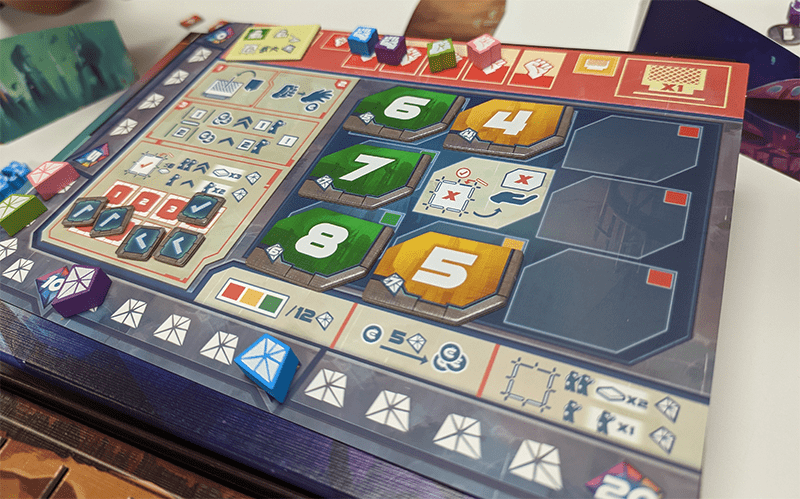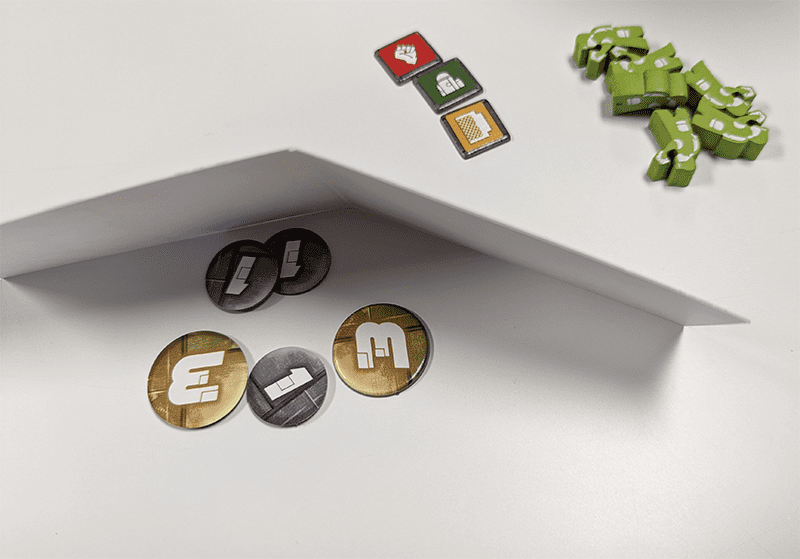Disclosure: Meeple Mountain received a free copy of this product in exchange for an honest, unbiased review. This review is not intended to be an endorsement.
One thing I can say with absolute certainty about myself, I love auction games. Modern Art was one of my first entries to the modern board game world, and Cyclades was glued to my gaming shelf for the longest time.
While that’s all good, another area that I know about myself is I am terrible at spatial puzzles. I can’t enjoy any Uwe Rosenberg game like Patchwork or A Feast for Odin because my brain refuses to function correctly when those games come up.
World Splitters wants to do both. Joy.
If the name sounds somewhat familiar, that’s because this is in the same setting as another game I reviewed called World Exchangers. World Exchangers is focused on oligarchs trading cities with each other. World Splitters is about oligarchs traveling to empty areas of interest and carving borders amongst themselves through an auction system. Areas of the map are enclosed once fences surround an area, and whoever has the most explorers scores for each space, while the second most explorers score for each explorer piece in the enclosed area.
That summary probably describes 50% of the game, so let’s talk about the other 50%.

Create your own personal boundaries
Going through a turn isn’t a daunting affair. You take a fence piece and jam it into one of the holes on the map. If either side of the fence is empty, the other players will place a bid via the classic closed-fist method by using the coins behind their screens. Yes, everyone’s coin supply is hidden.
Not only is it hidden, but the money supply doesn’t change, meaning the amount of money in the game will not increase or decrease. Everyone starts with 9 coins, and that’s it.
As for the bidding itself, you are technically bidding for the spot, but that’s not the full story here. If you win the bid, you have the possibility to put your explorer piece onto that space. The decision is ultimately up to the person who placed that fence.
The money you are bidding is the price you will pay to put an explorer piece or the amount of money you receive if the person who placed the fence wants to put their explorer instead of you. Bid 5 coins, and you’ll pay 5 coins to place an explorer, or you’ll get 5 coins, and the fence placer will place their explorer.
That sounds cool, yet it gets trickier. If there is a second space available, the second highest bidder goes through the same process, except unlike the highest bidder, they get the leftover space. It’s here where World Splitters demonstrates its deception.
Let’s say you bid 5, and your sibling bids 4. As the active player, I pay you 5 coins to place an explorer in a spot of my choice between the two. After I do that, I take your sibling’s 4 coins and they must place their explorer on the other spot. Because of this transaction, I paid 1 coin and moved 9 coins around the table. It’s a game that makes you want to make sly decisions.
While this sounds great, obviously the game can’t lean on auctions. Good news is there are other areas such as enclosure bonuses, set collection, and actions.
Buried treasure? No, just colored tokens
Dotted around the map are green, yellow, and red tokens. When you place an explorer piece on them, you immediately activate that token’s action and take it. Red is Initiative and Initiative is the tiebreaker in this game. Yellow allows you to place a fence in any empty non-enclosed spot but won’t trigger a bid. The green token depends on the map itself.
There are four maps in the game, with each map having its power and layout. For example, the winter map places an additional explorer in an empty non-enclosed space. Another map puts a tower that blocks that spot yet rewards five more points to whoever encloses that area with the most explorers.
Another way to score points is by enclosing areas. I don’t mean having the most explorers in an enclosed area; I mean simply triggering the scoring. Once you do this, you take the token, place it in front of you, and score those points. There are a few of these tokens, so this is a race.
Once there are eight areas enclosed, the game ends, and you do final scoring. You score bonus points for every set of red, green, and yellow tokens, including the enclosure tokens. Then the player with the lowest amount of money gives five points to the player with the highest amount of money. Finally, any spaces that haven’t been enclosed still count for scoring as if they were enclosed, just with lower values. Whoever has the most points wins, with ties being broken by Initiative.
I miss these kinds of games.

Have it your way
Most games nowadays try to inject a narrative or arc into the experience. World Splitters gives you a canvas for you and your friends to paint in. Everything is driven by the decisions of the players, while the rules merely set the stage.
Even placing your first fence is a butterfly effect that will ultimately fly back to you in one form or another. How you manipulate the money supply through auctions, how aggressively you bid, and where you place your fences build up momentum for the final few moments.
The design of World Splitters also encourages you to be clever by empowering you with tools to go nuts on everyone. Put fences in highly contested spots or bait people to give low bids so you swarm the land with your explorers. Close off areas to mess with opponents while swiping the precious enclosure tokens. It’s one of the few games out there that allows you to express yourself and showcase your intentions with bright neon lights invading the night sky.
There are so few games that do this anymore, which is why I am so fawning over it. Many games nowadays either have this highly tailored experience that is hard to deviate from with specific arcs or systems or throw in a massive campaign written by the cheapest they can find on Fiverr.
In World Splitters, you can bid as much as you want and place a fence anywhere you wish. There are no opening moves, no “proper” approach, and you have the freedom to succeed or fail as hard as you like. Emergent strategy is what this game is all about.
Creating poor decisions, together!
This focus on emergent strategy means the experience tilts towards the players at the table. To get a cutthroat game, you need a cutthroat group. World Splitters does not enforce this behavior, it merely gives you the tools to do so. Because of this, I have to point out that you need to be a fan of auctions, set collections, and spatial games to get entertainment from this one since it doesn’t offer much else. Rather than a random variety of mechanisms to deal with each game, your group’s decisions drive the replayability here.
As for the spatial puzzle portion, the game is not nearly as tough as anything by Uwe Rosenberg. I would say it’s more entry-level with a straightforward approach. World Splitters still highlights my incompetence in the genre, and that doesn’t bother me much like many other games. Unlike previous games, I want to master this one, which is praise I don’t serve often.
While I am stringing several sentences highlighting my enjoyment of World Splitters, I can’t say the same about its production. If you are reading this on MeepleMountain.com, you noticed the photos have the components on top of the box. It’s designed to do this.
I don’t like this for several reasons. A major complaint is that the thin cardboard fences are too small to fit into the slots. This results in fences titling more than a bar customer at New Year’s Eve. I know this sounds absolutely the stupidest thing to bring up, but hear me out.

Not all deals are fair
Board games are about visual information. Examine the board, understand the situation, and respond accordingly. When you have a game about closing areas with borders, you need to make those borders sit straight and not move. Tilted or, worse, sometimes falling off makes examining the board a complete pain. That’s not something I should experience in this type of game, yet here we are. It almost makes me want to steal a copy of Domaine and use the black wooden walls instead of these cardboard slots. Now that I just typed that sentence out, why didn’t they do this?!
Initiative is another issue. Although a tiebreaker line isn’t new, as shown in games like Libertalia: Winds of Galecrest, the issue lies in the limited options for moving up. Each map only has five red Initiative tokens, meaning the player who starts the game–who is lowest on the Initiative track–will have to win all five tokens to break all ties in a five-player game. Being first isn’t that helpful, so I don’t know why they thought this was a good idea. As a result, it doesn’t work well with five players and four players is pushing it, whereas three players is when it works best. Three player games are also beneficial since everybody is going to get something in a turn, as opposed to complete denial in higher player counts.
Fortunately, World Splitters does more right than wrong. Several ways to score points, and give the players the freedom to approach this system however they wish. In my early board game days, I played many games like this, and I miss that. I’m glad World Splitters wants to keep this design alive with a tightly designed package, and that is something worth praising.











Add Comment